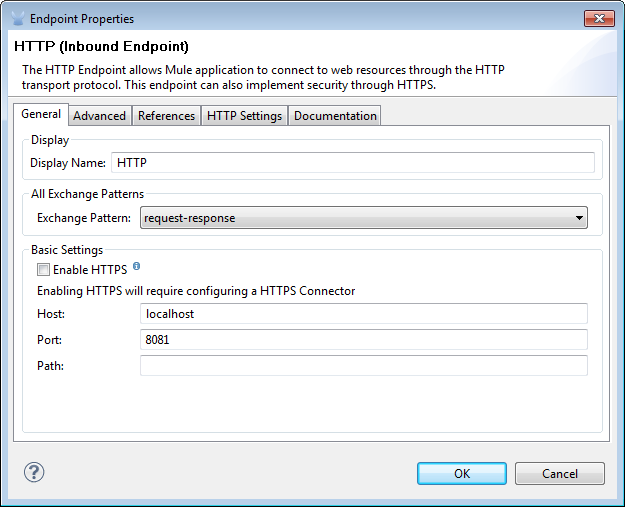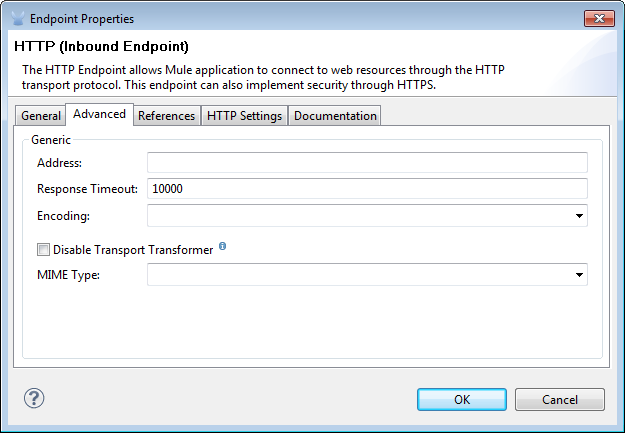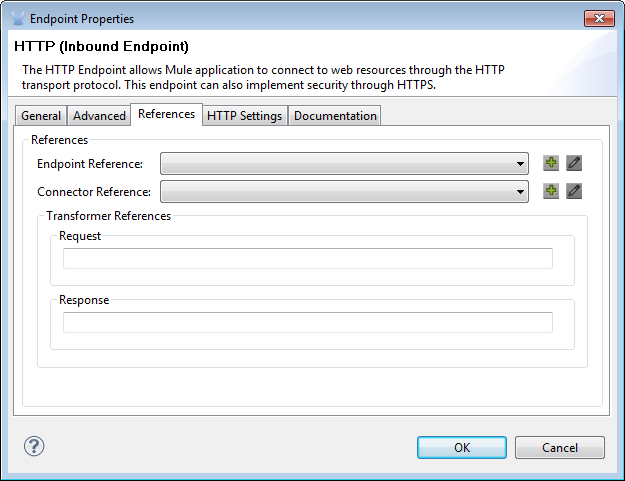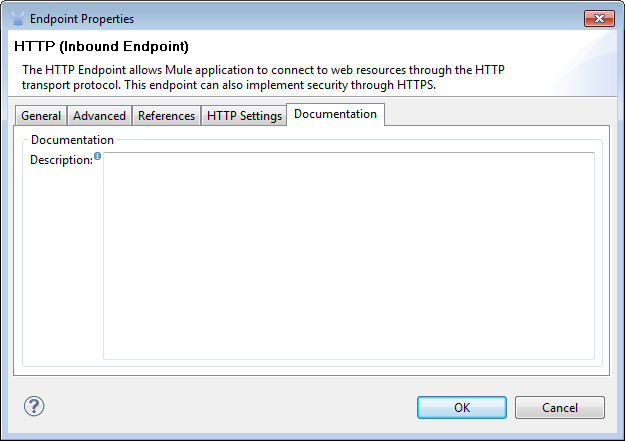
HTTP Endpoint Reference
Overview
The HTTP Endpoint allows Mule to send and receive requests using the HTTP transport protocol or HTTPS over the SSL protocol. Mule supports both inbound and outbound HTTP endpoints which can use request-response or one-way as exchange pattern.
Configuration
You configure the HTTP endpoint in three stages:
-
Choose between a one-way or request-response exchange pattern. (For details, see: About Main Flows). The default exchange pattern for the HTTP/HTTPS endpoints is request-response. Also, decide whether you want to implement security through HTTPS.
-
Decide where you want to place the HTTP endpoint within your Mule flow, then drag it from the Palette to the appropriate place in the sequence of building blocks that make up your Mule flow.
-
If you place it at the beginning of the flow, it will act as an inbound endpoint (i.e., the message source), triggering the flow whenever it receives a message. (You can also use the Composite Source scope to wrap the HTTP endpoint with other, similar endpoints (such as HTTPS and Servlet) so that your flow can receive messages through multiple transport channels).
-
If you place the HTTP building block in the middle or at the end of the flow, it will serve as an outbound endpoint, passing information out of the flow to external Web resources.
-
Configure the HTTP endpoint by providing values for the fields on the various tabs on the Properties pane, which you can open by double-clicking the HTTP icon on the Message Flow canvas.
General Tab
This tab contains four panels, as detailed below:

| Field | Description |
|---|---|
Display Name |
Enter a display name that describes the endpoint’s role in your flow, such as "HTTP to Customer Web site". |
Exchange Pattern |
If set to one-way, the HTTP endpoint will send the incoming message to the next building block in the flow. If set to request-response, the endpoint will wait for a response before sending the message to the next building block. Request-response is the default. |
Enable HTTPS |
Check this box to send messages using HTTPS on the endpoint. By default, HTTPS is off. |
Host |
Defaults to localhost. Enter the Fully Qualified Domain Name (FQDN) or IP address of the server on your host machine that will connect to the external HTTP server. |
Port |
The port that connects to the local (host) server. (i.e., 8081) |
Path |
Specify a path that facilitates connection to the local server so that you don’t have to provide a username and password. |
Method |
(Applies to outbound HTTP endpoint only). Select from a drop-down list the action the endpoint will execute. e.g., POST or GET |
Advanced Tab

| Field | Description |
|---|---|
Address |
Enter the address for this endpoint, i.e. |
Response Timeout |
Specify how long (in ms) the endpoint must wait for a response. |
Encoding |
Choose form a drop-down list the encoding scheme used for message data, i.e., |
Disable Transport Transformer |
Check this box to prohibit the endpoint from using the default transformers associated with the endpoint’s transport. |
MIME Type |
Sets the message type used by the endpoint to send and receive messages, i.e. |
Follow Redirects |
(Applies to Outbound HTTP endpoints only). Enables automatic redirection of URLs for HTTP GET exchanges. |
References Tab

| Field | Description |
|---|---|
Endpoint Reference |
From the drop-down list, select, Add, or Edit a Global Element template for HTTP endpoints. |
Connector Reference |
From the drop-down list, select, Add, or Edit a Global Element Connector template that provides connection information for HTTP endpoints. |
Request Transformer References |
Enter a list of synchronous transformers that will be applied to the request before it is sent to the transport. |
Response Transformer References |
Enter a list of synchronous transformers that will be applied to the response before it is returned from the transport. |
HTTP Settings Tab

| Panel | Panel description |
|---|---|
User |
The username for authentication on the host server. |
Password |
The password for authentication on the host server. |
Content Type |
This setting identifies the file format messages are sent from the endpoint. e.g., |
Keep Alive |
This setting controls if the socket connection remains open. Check this box to keep the socket connection open and return a keep-alive header with connection information. |
Reference Documentation
See the HTTP Transport Reference for details on setting the properties for an HTTP endpoint using an XML editor.




